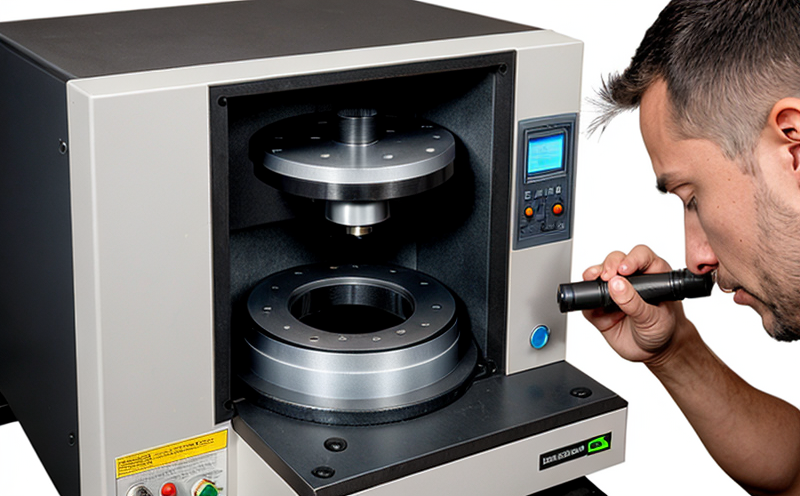ASTM E112 Grain Size Measurement by Metallography
The ASTM E112 standard provides a precise method for grain size analysis in metallic materials. This service is crucial for ensuring the quality and consistency of materials used across various industries, including aerospace, automotive, and manufacturing sectors. Grains are the basic microstructural elements that make up metals; their uniformity and size can significantly influence the mechanical properties of the material.
The ASTM E112 grain size measurement by metallography involves several detailed steps to ensure accurate results. The first step is specimen preparation, which includes cleaning and etching to reveal the microstructure. Etchants like Nital (nitric acid and ethanol) are commonly used for this purpose. After preparation, the sample is observed under a microscope using transmitted light, polarized light, or reflected light techniques.
The process of grain size measurement by metallography involves several key steps:
- Microstructure examination: Using high-resolution microscopes to identify and measure grains accurately.
- Grain counting and sizing: Carefully counting the number of grains within a defined area and measuring their diameters or equivalent circles.
- Statistical analysis: Applying statistical methods to determine the average grain size as per ASTM E112 standards.
The final step is reporting, where detailed reports are generated summarizing the findings. Reporting includes tables detailing grain sizes and any observations made during the examination process. This data is vital for quality control, material characterization, and compliance with industry standards.
ASTM E112 grain size measurement by metallography plays a critical role in ensuring that materials meet specific performance criteria. For instance, in aerospace applications, the uniformity of grains can affect fatigue strength and durability. In automotive manufacturing, consistent grain sizes contribute to better wear resistance and reliability.
When conducting ASTM E112 tests, it is essential to follow the standard meticulously to ensure accurate results. Compliance with these standards not only ensures product quality but also supports regulatory compliance and customer satisfaction. By adhering to ASTM E112, manufacturers can be confident that their materials meet stringent industry requirements.
In conclusion, ASTM E112 grain size measurement by metallography is a critical service for industries reliant on metallic materials. Its precision ensures consistent quality, supports regulatory compliance, and enhances product performance. Understanding the process and its importance in your specific application can help you make informed decisions about material selection and quality control.
Benefits
The benefits of ASTM E112 grain size measurement by metallography are numerous and far-reaching, particularly for industries that rely heavily on metallic materials. Here are some key advantages:
- Enhanced Material Quality: Ensures consistent grain sizes across batches, which can significantly improve the mechanical properties of metals.
- Improved Compliance: Helps manufacturers meet stringent industry and regulatory standards, ensuring compliance with international guidelines such as ASTM E112.
- Informed Decision-Making: Provides detailed insights into material performance, enabling informed decisions regarding material selection and process optimization.
- Increased Reliability: Ensures that materials used in critical applications are reliable and consistent, reducing the risk of failures in end products.
- Cost Efficiency: By identifying potential issues early in the production process, this service helps avoid costly rework or scrap.
- Innovation Support: Assists R&D teams in developing new materials with improved properties by providing accurate and reliable data.
- Customer Satisfaction: Ensures that products meet high-quality standards, leading to increased customer satisfaction and loyalty.
- Competitive Advantage: By maintaining consistent quality and meeting industry benchmarks, companies can gain a competitive edge in the market.
In summary, ASTM E112 grain size measurement by metallography is essential for ensuring high-quality metallic materials that meet both internal and external expectations. It supports innovation, enhances reliability, and boosts overall business performance.
Eurolab Advantages
At Eurolab, we pride ourselves on providing comprehensive testing services that go beyond the standards, ensuring excellence in every service we offer. Here are several advantages of choosing our ASTM E112 grain size measurement by metallography:
- Expertise and Experience: Our team comprises highly skilled professionals with extensive experience in materials science and metallography.
- State-of-the-Art Facilities: Equipped with advanced microscopes and etching equipment, we offer precise and reliable testing results.
- Comprehensive Reporting: We provide detailed reports that not only meet but exceed industry expectations, ensuring clear communication of findings.
- Rapid Turnaround Times: Our efficient processes allow for quick turnaround times without compromising on quality.
- Custom Solutions: Tailored testing solutions to meet the specific needs of our clients across various industries.
- Continuous Improvement: We are committed to staying updated with the latest standards and methodologies, ensuring that we offer the most accurate and reliable services.
- Comprehensive Support: Our customer support team is available to assist you throughout your testing process, from initial consultation to final report delivery.
At Eurolab, our commitment to quality and excellence ensures that every ASTM E112 grain size measurement by metallography service we provide meets the highest standards. We are dedicated to supporting your success with reliable and precise results.
Customer Impact and Satisfaction
The impact of ASTM E112 grain size measurement by metallography on our customers is profound, influencing various aspects of their operations. Here's how this service impacts different stakeholders:
- Quality Managers: Gain critical insights into the quality of materials used in production processes, enabling informed decision-making.
- Compliance Officers: Ensure that all materials meet stringent industry and regulatory standards, supporting compliance efforts.
- R&D Engineers: Develop new materials with improved properties by leveraging accurate grain size data.
- Procurement Teams: Make informed purchasing decisions based on reliable testing results, ensuring the right materials are selected for specific applications.
The satisfaction of our customers is a top priority at Eurolab. Our focus on accuracy, reliability, and customer service ensures that every ASTM E112 grain size measurement by metallography service we provide meets or exceeds expectations. We strive to build long-term relationships with our clients by consistently delivering high-quality results.





